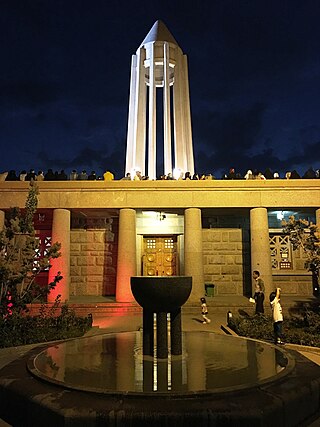The Persians or Iranian Persians are an Iranian ethnic group who comprise over half of the population of Iran. They share a common cultural system and are native speakers of the Persian language as well as of the languages that are closely related to Persian.

Ecbatana was an ancient city and the capital of the Median kingdom, making it the first capital of Iran. It later became the summer capital of the Achaemenid and Parthian empires. It was also an important city during the Seleucid and Sasanian empires. It is believed that Ecbatana is located in the Zagros Mountains, the east of central Mesopotamia, on Hagmatana Hill. Ecbatana's strategic location and resources probably made it a popular site even before the 1st millennium BC. Along with Athens in Greece, Rome in Italy and Susa in Khuzestan, Ecbatana is one of the few ancient cities in the world that is still alive and important, representing the current-day Hamadan.

Hamadan Province is one of the 31 provinces of Iran. Its capital is the city of Hamadan. In the Zagros Mountains, the province covers an area of 19,546 km2.

Alvand is a subrange of the Zagros Mountains in western Iran located 10 km (6.2 mi) south of the city of Hamadan in Hamadan Province. Its summit has an elevation of 3,580 m (11,750 ft). The main body of the Alvand range extends for about 50 km from east to west, while their maximum north-south width is about 30 km. Formed as part of the Zagros orogeny in the late Jurassic and early Cretaceous, the mountains rise sharply from the surrounding plains and are scored by many deep valleys. The mountains are mostly granite and diorite, which are types of intrusive rock.
Iranian Armenians, also known as Persian Armenians, are Iranians of Armenian ethnicity who may speak Armenian as their first language. Estimates of their number in Iran range from 70,000 to 500,000. Areas with a high concentration of them include Tabriz, Tehran, Salmas and New Julfa,Isfahan.

Media is a region of north-western Iran, best known for having been the political and cultural base of the Medes. During the Achaemenid period, it comprised present-day Iranian Azerbaijan, Iranian Kurdistan and western Tabaristan. As a satrapy under Achaemenid rule, it would eventually encompass a wider region, stretching to southern Dagestan in the north. However, after the wars of Alexander the Great, the northern parts were separated due to the Partition of Babylon and became known as Atropatene, while the remaining region became known as Lesser Media.
Kangavar is a city in the Central District of Kangavar County, Kermanshah province, Iran, serving as capital of both the county and the district.
The majority of the population of Iran consists of Iranic peoples. The largest groups in this category include Persians and Kurds, with smaller communities including Gilakis, Mazandaranis, Lurs, Tats, Talysh, and Baloch.
The following is a timeline of the history of the city of Tehran, Iran.
The following is a timeline of the history of the city of Tabriz, capital of East Azerbaijan Province in Iran.

Muhammad ibn Rustam Dushmanziyar, also known by his laqab of Ala al-Dawla Muhammad, was a Daylamite military commander who founded in 1008 the short-lived but important independent Kakuyid dynasty in Jibal. He is also known as Pusar-i Kaku, Ibn Kakuyeh, Ibn Kakuya, and Ibn Kaku, which means maternal uncle in the Deylami language, and is related to the Persian word "kaka". Muhammad died in September 1041 after having carved out a powerful kingdom which included western Persia and Jibal. However, these gains were quickly lost under his successors.

Hamadan is a city in western Iran. It is located in the Central District of Hamadan County in Hamadan province, serving as the capital of the province, county, and district. As of the 2016 Iranian census, it had a population of 554,406 people in 174,731 households.

Qajar Iran, also referred to as Qajar Persia, the Qajar Empire, Sublime State of Persia, officially the Sublime State of Iran and also known as the Guarded Domains of Iran, was an Iranian state ruled by the Qajar dynasty, which was of Turkic origin, specifically from the Qajar tribe, from 1789 to 1925. The Qajar family took full control of Iran in 1794, deposing Lotf 'Ali Khan, the last Shah of the Zand dynasty, and re-asserted Iranian sovereignty over large parts of the Caucasus. In 1796, Agha Mohammad Khan Qajar seized Mashhad with ease, putting an end to the Afsharid dynasty. He was formally crowned as Shah after his punitive campaign against Iran's Georgian subjects.
The following is a timeline of the history of the city of Shiraz, Iran.
The following is a timeline of the history of the city of Bandar Abbas, Iran.

The following is a timeline of the history of the city of Isfahan, Iran.
The following is a timeline of the history of the city of Mashhad, Iran.
The following is a timeline of the history of the city of Qom, Iran.
The following is a timeline of the history of the city of Kerman, Iran.
The following is a timeline of the history of the city of Yazd, Iran.









